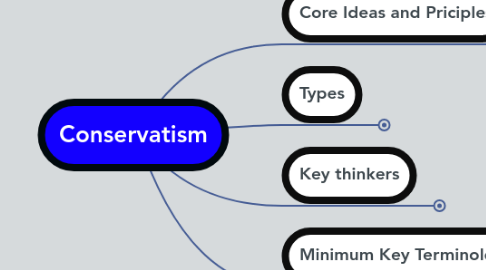
1. Key thinkers
1.1. Thomas Hobbes
1.2. Edmund Burke
1.3. Michael Oakeshott
1.4. Ayn Rand
1.5. Robert Nozick
2. Types
2.1. Traditional Conservatism
2.1.1. Original
2.1.1.1. Edmund Burke: Reflections on the Revolution in France (1790)
2.1.1.2. Avert revolution = change to conserve
2.1.1.3. Prime Ministers: Pitt, Canning, Peel
2.1.1.4. Catholic emancipation, abolition of slavery
2.1.1.5. Harness the new business class, Great Reform Act 1832
2.1.2. One Nation Conservatism
2.1.2.1. Avert threat of socialism = change to conserve
2.1.2.2. Disraeli (UK), Bismarck (Germany)
2.1.2.3. Different classes = little platoons = one nation = NO REVOLUTION
2.1.2.4. Nation = essence of the status quo
2.1.2.5. State sponsored reform to temper laissez-faire economics
2.1.2.6. Factory Act 1874, Bismarck’s German welfare state
2.1.3. 20th century
2.1.3.1. Even greater government intervention
2.1.3.2. Need to avert socialist or fascist revolutions
2.1.3.3. Macmillan’s “middle way”
2.1.3.4. Post-WW2 adopted Keynesian economics, welfare state, mixed economy, extensive state ownership = evolution of one-nation paternalism
2.2. Christian Democracy
2.2.1. Post WW2 European Conservatism evolved differently to UK
2.2.2. Adenauer, Schuman, Sturzo
2.2.3. Reject one-nation in favour of supranationalism
2.2.4. More socially conservative
2.2.5. Maintained their scepticism of free market economics
2.3. New Right Conservatism
2.3.1. Rand (atomism), Nozick (monarchist state), Hayek (Road to Serfdom)
2.3.2. Individual freedom, laissez-faire capitalism, private property, minimal government
2.3.3. Natural home is USA
2.3.4. Blends neo-liberalism with neo-conservatism
2.3.4.1. Neo-liberalism (save individual from the state)
2.3.4.1.1. Focus on individual rather than society
2.3.4.1.2. Reduced taxes
2.3.4.1.3. Privatisation
2.3.4.1.4. Reduced government role / spending
2.3.4.1.5. Deregulation of industry
2.3.4.1.6. Restrict power of trade unions and local councils
2.3.4.2. Neo-conservatism (restore order and security)
2.3.4.2.1. More powers for police and judiciary
2.3.4.2.2. More defence spending
2.3.4.2.3. Less tolerance of immigration
2.3.4.2.4. Anti-permissive policies to protect morals
2.3.5. Trigger point = stagflation of the mid-70s = evidence of failure of Traditional Conservatism
2.3.6. Thatcher, Reagan
2.3.7. Adam Smith Institute, Institute for Economic Affairs, Milton Friedman
2.3.8. Arguably contradicts traditional conservative values
3. Core Ideas and Priciples
3.1. Origins/core beliefs
3.1.1. Change to conserve
3.1.2. Bends to circumstances
3.1.3. French Revolution
3.1.4. Enlightenment - a reaction to it
3.2. Human nature
3.2.1. Life is nasty, brutish and short
3.2.2. Rationality = form a (loose) state
3.2.3. Imperfection – fallible but not terrible
3.2.3.1. Psychological
3.2.3.2. Moral
3.2.3.3. Intellectual
3.2.4. Naturally communal = little platoons
3.2.5. Yearn for freedom
3.2.6. Self-interested
3.3. Society
3.3.1. Localism = little platoons
3.3.2. Organicism = gradual change
3.3.3. Empiricism = change on the basis of facts
3.3.4. Tradition = hold on to what’s good in a changing world
3.3.5. Hierarchy = natural, noblesse oblige, hard/soft paternalism
3.3.6. Judeo-Christian morality = original sin, ethical guidance, altruism, compassion, marriage, family, accountability
3.3.7. Property rights – tradition and hierarchy means support for inherited wealth
3.4. The state
3.4.1. Order and authority
3.4.2. Requirement for order and authority means state precedes society
3.4.3. Organic origins rather than revolutionary
3.4.4. Ruling class
3.4.5. Emphasis on nation-state from mid-19th century
3.4.6. UK conservatives dubious of supranational state
3.5. The economy
3.5.1. Capitalism = inequality and hierarchy
3.5.2. Laissez-faire economics, Adam Smith, free markets
3.5.3. Paradox = capitalism may lead to rapid, radical change
3.5.4. Traditional conservative = Keynesian economics
3.5.5. New Right conservatives = neoliberal
3.5.5.1. Deregulated markets
3.5.5.2. Privatisation
3.5.5.3. Lower taxes
3.5.5.4. Reduce role for government
3.5.5.5. Focus on individual rather than society
3.5.5.6. Restrict power of trade unions and local councils
